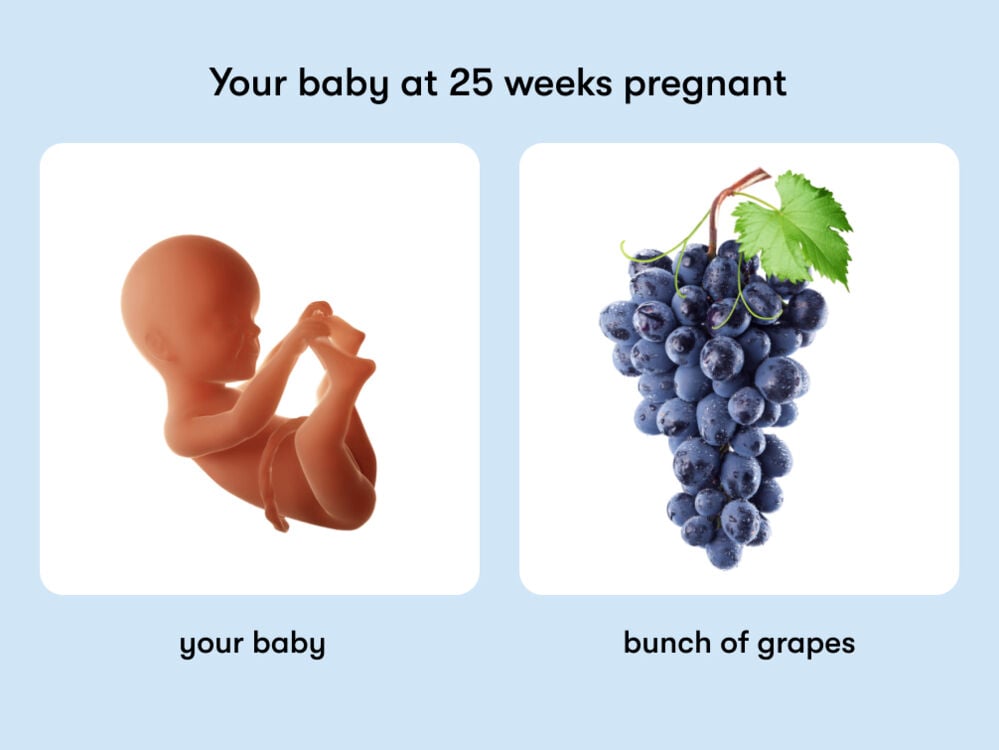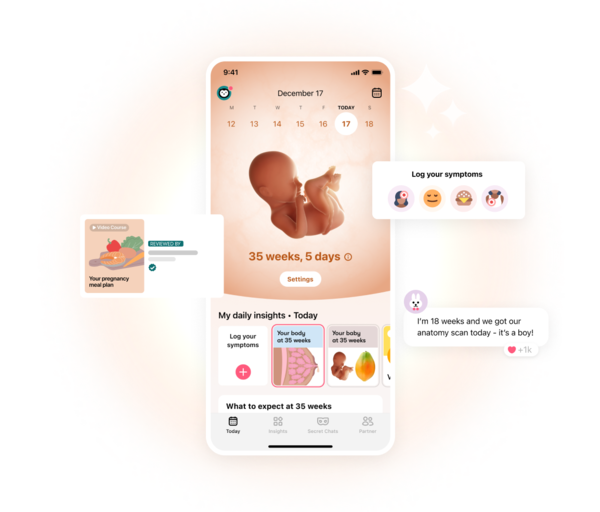From your baby changing position to restless legs syndrome, here’s the lowdown on being 25 weeks pregnant.
-
Tracking cycle
-
Getting pregnant
-
Pregnancy
-
Help Center
-
Flo for Partners
-
Anonymous Mode
-
Flo app reviews
-
Flo Premium New
-
Secret Chats New
-
Symptom Checker New
-
Your cycle
-
Health 360°
-
Getting pregnant
-
Pregnancy
-
Being a mom
-
LGBTQ+
-
Quizzes
-
Ovulation calculator
-
hCG calculator
-
Pregnancy test calculator
-
Menstrual cycle calculator
-
Period calculator
-
Implantation calculator
-
Pregnancy weeks to months calculator
-
Pregnancy due date calculator
-
IVF and FET due date calculator
-
Due date calculator by ultrasound
-
Medical Affairs
-
Science & Research
-
Pass It On Project New
-
Privacy Portal
-
Press Center
-
Flo Accuracy
-
Careers
-
Contact Us
25 weeks pregnant: Your guide to this week of your second trimester


Every piece of content at Flo Health adheres to the highest editorial standards for language, style, and medical accuracy. To learn what we do to deliver the best health and lifestyle insights to you, check out our content review principles.
At 25 weeks pregnant, it can all start to feel very real. You’re officially well over halfway to full term.
While it is undoubtedly an exciting time, it’s natural to also feel anxious about the changes happening to your body. Knowing what to expect can help you feel more prepared and confident, so here are the key symptoms and milestones to be aware of at this time, including advice from a Flo expert.
Your baby at 25 weeks pregnant
Your baby might change position
When you’re 25 weeks pregnant, your baby might be changing position frequently. It’s common for babies to move around into a variety of positions during pregnancy.
Your baby is peeing
It can be a funny thought, but your baby at 25 weeks of pregnancy is now peeing. Weird, right? In fact, the fluid surrounding them in your uterus — called the amniotic fluid — is now mainly made up of pee. This fluid is constantly circulating around your baby, who keeps swallowing it and then peeing it out. This might sound odd, but rest assured, it’s completely normal. This water-like substance is actually good for your baby, as it’s full of nutrients, hormones, antibodies, and other fluids to help keep them healthy. Fun fact: If you later notice your water break, which can be a key stage of labor, it’s the amniotic fluid that leaks from your vagina.
How big is a baby at 25 weeks?
Length (crown to heel): 33.7 cm or 13.3 in.
Weight: 785 g or 1.7 lb.
Size: Equivalent to a bunch of grapes
All measurements are approximate and vary within the normal range.

Your body at 25 weeks pregnant
Swollen legs and feet
Have you noticed that you’re getting swollen legs and feet? Don’t worry — this is a classic (and often frustrating) pregnancy symptom. It might feel alarming at first, but the swelling is common at 25 weeks pregnant. It’s caused by your body holding in more water than usual alongside your growing uterus putting more pressure on your veins. This can affect blood flow and cause fluid to build up in your legs, ankles, and feet. Around 8 in 10 pregnant women experience water retention, so if you’re struggling with this, know that you are definitely not alone.
If you can, doing foot exercises, resting, and avoiding standing for long periods are some of the things that can help. And don’t cut back on your water intake. Oddly enough, drinking it actually helps to get rid of the excess water (yes, really!). Read our guide on how to reduce swelling for more helpful tips.
Just so you know, you should contact your health care provider if the swelling is accompanied by any of the following symptoms:
- A sudden increase in swelling
- A bad headache
- Problems with your vision
- Severe pain just below your ribs
- Vomiting with any of these symptoms
- Shortness of breath
Although getting swollen legs and feet is common during pregnancy, not everyone gets this symptom. So don’t worry if your legs and feet look no different than usual.
Restless legs syndrome
If you haven’t heard of restless legs syndrome, you’re probably wondering what exactly this odd-sounding symptom is. We asked Dr. Cynthia DeTata, clinical assistant professor of obstetrics and gynecology, Lucile Packard Children’s Hospital, California, US, to explain.
“To summarize, it is an uncomfortable feeling when lying down at rest or trying to sleep that is accompanied by an overwhelming urge to move one’s legs,” she explains. “This can be a slight nuisance or severe enough to interfere with sleep. Getting good sleep is difficult anyway during pregnancy, and this can significantly impact sleep and, subsequently, the wellbeing of the mother.” As frustrating as it can be to struggle with sleep during pregnancy, it can be reassuring to know that feeling tired won’t harm your baby.
Dr. DeTata continues, “Restless legs syndrome is very common in pregnancy, particularly in the second and third trimesters.” In fact, research shows that 10% to 34% of pregnant women experience this symptom, so you’re certainly in good company if you do too.
Certain things put some people more at risk of developing restless legs syndrome during pregnancy. The main factors are:
- Having the syndrome before conception
- Having the syndrome during a previous pregnancy
- Iron deficiency
- Vitamin D deficiency
- Stomach ulcer
- Drinking coffee before pregnancy
Now for some good news: There are a few things that can help to ease restless legs syndrome, including:
- Getting regular, light exercise, such as bike riding or walking
- Applying a heating pad, cold compress, or rubbing your legs
- Reducing stress as much as possible
- Taking a warm bath
- If it’s affecting your sleep, then following good sleep habits (like avoiding looking at a screen while lying in bed)
- Avoiding caffeine, nicotine, and alcohol
Trying magnesium supplements (Although Dr. DeTata adds that there is mixed evidence that this works: “Magnesium and calcium supplementation may help with the symptoms of restless leg syndrome, but the evidence on this is mixed, with some studies finding it is helpful and others that it is not.” If you want to try it, then remember to speak to your doctor before taking any new supplements.)
If none of the above work for you, then don’t suffer in silence. Reach out to your doctor if you’re experiencing frequent or severe restless legs syndrome symptoms, as there are numerous treatment options available. They will discuss the best treatment for you, which might include certain prescription medications. And if restless legs syndrome is disrupting your precious sleep, our guide on how to cope with pregnancy insomnia might help.
Your questions answered
What should you try to avoid at 25 weeks pregnant?
As with every other week of your pregnancy, the things to avoid at 25 weeks pregnant include alcohol, large amounts of caffeine, certain types of fish, and processed meats.
Thinking about adding some healthy foods to your diet is just as important as monitoring what to avoid. “Remember that you need about 300 additional calories a day,” says Dr. DeTata. “These should incorporate fruits in their whole form (not juice), vegetables, and low-fat protein. You should strive to eat high-fiber, more complex carbohydrates, rather than simple carbs such as white rice and white bread, as your body turns them into sugar. Also avoid sweetened drinks — even if they are billed as being healthy and naturally sweetened — and of course, junk food.”
While it’s good to keep your diet as healthy as possible, it’s OK to indulge every now and again. So if you find yourself reaching for the cookie jar instead of the carrot sticks, don’t be too hard on yourself about it.
What position is my baby in at 25 weeks?
You might be wondering what your little wriggler is up to in there. Right now, your baby could be in any position, says Dr. DeTata. After all, as we mentioned earlier, they’re constantly moving around in your uterus. “At this point your baby flips and twists all around, even from moment to moment when we are watching on ultrasound,” she says. “Since the position changes so much, we generally don’t worry about a baby being head down until around 35 to 36 weeks of pregnancy.”
Are you seven months pregnant at 25 weeks?
Wondering how to calculate 25 weeks pregnant in months? At this stage, you have just started your seventh month of pregnancy. Dr. DeTata says, “This is a time when most people start to feel better, have more energy, their nausea and food aversions abate, and their appetite can return in full force! It’s also a time when many go from little to rapid weight gain.”
But if this experience doesn’t exactly match up with yours, that doesn’t necessarily mean that anything is wrong with you or your baby. Remember, every pregnancy is different, and your body (and baby) will do their own thing.
Take a quiz
Find out what you can do with our Health Assistant
25 weeks pregnant checklist
Get dietary copper
During pregnancy, your body needs more of the mineral copper. If you don’t have enough, it can have a negative impact on the development of your baby’s lungs, skin, bones, and immune system. However, it’s recommended that you get the extra copper you need through food rather than supplements. Some of the richest sources of copper that are safe to eat during pregnancy include seeds and nuts, wheat bran cereals, whole grain products, and, saving the best until last, chocolate.
Moisturize your belly
Unfortunately, getting itchy skin is common during pregnancy. It can be caused by hormonal changes or by your growing belly stretching your skin. Luckily, moisturizers can help to soothe your itchy belly while preventing dry skin. Taking a cool bath and wearing loose-fitting clothes made from natural materials can also help.
Having itchy skin doesn’t mean that anything is wrong, but it sure can be annoying. If the itching is really bothering you, worse at night, or worse on the palms of your hands and soles of your feet, then it’s worth speaking to your doctor about it.
Itchy skin can also be the first sign of stretch marks. However, be wary of any “miracle” moisturizing products that promise to prevent stretch marks from appearing. “While stretch marks might start to appear at this stage, be informed that no cream or product prevents them,” says Dr. DeTata. “They occur due to collagen stretching and the fibers rupturing under the skin. Most treatments are surface treatments. Anything that might penetrate deeper could be a danger to your baby.”
And ultimately, of course, stretch marks are nothing to be ashamed of. It can be difficult to adjust to the changes happening to your body, but know that an increasing number of people are choosing to embrace and show off their stretch marks with pride.
Start thinking about maternity leave
Now can be a good time to start thinking about your maternity leave, if you haven’t already. Depending on which country or state you live in, the minimum maternity leave will vary. The amount of pay you will receive while not working also varies greatly between different countries, states, and employers. It can be really helpful to know what you’re entitled to and how this could affect your household’s finances, so doing a bit of research now can pay off later on.
If you’re wondering about the best time to go on maternity leave, there are a few things to consider. For example, what are the physical demands of your job? If you have a long and tiring commute or your work requires you to be physically active, you may want to go on maternity leave sooner. Other circumstances where you may want to stop working earlier are if you’re having twins, which can be more tiring, or if you have any special health needs.
You might also want to start thinking about any handovers you’ll need to do or who will cover you in your absence. You’ve still got plenty of time left to think these things through, but feeling prepared can help you stay relaxed as your pregnancy progresses.
When to consult a doctor at 25 weeks pregnant
You don’t need to wait until your appointment if you have any concerns or questions about your pregnancy. However, at 25 weeks pregnant, you should contact your doctor immediately if you experience:
- Severe cramping
- Vaginal bleeding
- Changes in vaginal discharge
- Fever
- Dizziness or fainting
- Severe vomiting
- Severe headaches or blurry vision
- Intense heartburn
- A decrease in the amount you feel your baby move
- A loss of liquid from your vagina or watery/mucus-like discharge (this could be a sign of premature labor)
This isn’t an exhaustive list and just an example of some of the changes you should look out for. Some of these can be a sign of health complications, so it’s essential that you speak to your doctor about the best next step for you. And if you’re ever worried about any other symptoms you experience during pregnancy, then don’t hesitate to reach out to your health care provider.
You should otherwise be seeing your health care provider at regular prenatal visits. These sometimes happen around every four weeks throughout the second trimester, depending on where you live and what’s right for your pregnancy. These appointments may include routine lab tests, checking your baby’s growth, and measuring your vitals like blood pressure and weight. And as we said, if you have anything on your mind that’s worrying or bothering you, it can be reassuring to speak to your doctor about it. Even if you think it sounds trivial, they’ll be happy to help.
25 Weeks Pregnant: The takeaway
This week, you might be enjoying feeling your baby moving, having more energy, or embracing the return of your appetite. On the other hand, you may be struggling with swollen ankles, restless legs syndrome, and stretch marks. Pregnancy can be an emotional (and physical) roller coaster. However your symptoms are showing up this week, remember to be kind to yourself and take it all one day at a time.


Hey, I'm Anique
I started using Flo app to track my period and ovulation because we wanted to have a baby.


The Flo app helped me learn about my body and spot ovulation signs during our conception journey.


I vividly
remember the day
that we switched
Flo into
Pregnancy Mode — it was
such a special
moment.
Real stories, real results
Learn how the Flo app became an amazing cheerleader for us on our conception journey.
References
“Amniotic Fluid.” Cleveland Clinic, my.clevelandclinic.org/health/body/23310-amniotic-fluid. Accessed 26 June 2023.
“Bleeding during Pregnancy.” The American College of Obstetricians and Gynecologists, May 2021, www.acog.org/womens-health/faqs/bleeding-during-pregnancy.
“What Not to Eat When You’re Pregnant.” Cleveland Clinic, 20 Oct. 2022, health.clevelandclinic.org/what-not-to-eat-when-youre-pregnant/
“Copper.” National Institutes of Health, 18 Oct. 2022, ods.od.nih.gov/factsheets/Copper-HealthProfessional/.
Davison, J. M. “Edema in Pregnancy.” Kidney International Supplement, vol. 59, June 1997, pp. S90–96, pubmed.ncbi.nlm.nih.gov/9185112/.
“Fetal Development.” Cleveland Clinic, my.clevelandclinic.org/health/articles/7247-fetal-development-stages-of-growth. Accessed 15 June 2023.
Curran, Mark A. “Fetal Development.” Perinatology.com, perinatology.com/Reference/Fetal%20development.htm. Accessed 26 June 2023.
“Fetal Positions for Birth.” Cleveland Clinic, my.clevelandclinic.org/health/articles/9677-fetal-positions-for-birth. Accessed 26 June 2023.
Friel, Lara A. “Fevers during Pregnancy.” MSD Manual Consumer Version, Oct. 2021, www.msdmanuals.com/home/women-s-health-issues/pregnancy-complicated-by-disease/fevers-during-pregnancy.
Gluckman, Peter, et al. “Copper in Pregnancy and Breastfeeding.” Nutrition & Lifestyle for Pregnancy & Breastfeeding. Oxford University Press, 2014, academic.oup.com/book/29596/chapter-abstract/249343579.
Gupta, R., et al. “Restless Legs Syndrome and Pregnancy: Prevalence, Possible Pathophysiological Mechanisms and Treatment.” Acta Neurologica Scandinavica, vol. 133, no. 5, May 2016, pp. 320–29, www.ncbi.nlm.nih.gov/pmc/articles/PMC5562408/.
“Itching and Intrahepatic Cholestasis of Pregnancy.” NHS, www.nhs.uk/pregnancy/related-conditions/complications/itching-and-intrahepatic-cholestasis/. Accessed 26 June 2023.
“Kick Counts.” Cleveland Clinic, my.clevelandclinic.org/health/articles/23497-kick-counts. Accessed 14 June 2023.
“Maternity Leave.” Tommy’s, Tommys.org/get-involved/companies/pregnancy-at-work/maternity-leave-employee. Accessed 26 June 2023.
“Maternity Leave by Country 2023.” World Population Review, worldpopulationreview.com/country-rankings/maternity-leave-by-country. Accessed 26 June 2023.
“Morning Sickness: Nausea and Vomiting of Pregnancy.” The American College of Obstetricians and Gynecologists, May 2020, www.acog.org/womens-health/faqs/morning-sickness-nausea-and-vomiting-of-pregnancy.
“Preeclampsia.” Cleveland Clinic, https://my.clevelandclinic.org/health/diseases/17952-preeclampsia. Accessed 26 June 2023.
“Heartburn during Pregnancy.” Cleveland Clinic, my.clevelandclinic.org/health/diseases/12011-heartburn-during-pregnancy. Accessed 14 June 2023.
“Prenatal Care: 2nd Trimester Visits.” Mayo Clinic, 4 Aug. 2022, www.mayoclinic.org/healthy-lifestyle/pregnancy-week-by-week/in-depth/prenatal-care/art-20044581.
“Preterm Labor.” Mayo Clinic, 8 Feb. 2022, www.mayoclinic.org/diseases-conditions/preterm-labor/symptoms-causes/syc-20376842.
“Restless Legs Syndrome.” Cleveland Clinic, my.clevelandclinic.org/health/diseases/9497-restless-legs-syndrome. Accessed 26 June 2023.
“Stretch Marks in Pregnancy.” NHS, https://www.nhs.uk/pregnancy/related-conditions/common-symptoms/stretch-marks/. Accessed 26 June 2023.
“Swollen Ankles, Feet and Fingers in Pregnancy.” NHS, www.nhs.uk/pregnancy/related-conditions/common-symptoms/swollen-ankles-feet-and-fingers/. Accessed 26 June 2023.
“Tiredness and Sleep Problems.” NHS, www.nhs.uk/pregnancy/related-conditions/common-symptoms/tiredness/. Accessed 26 June 2023.
“Urgent Maternal Warning Signs.” Centers for Disease Control and Prevention, 27 Feb. 2023, www.cdc.gov/hearher/maternal-warning-signs/index.html.
“Vaginal Discharge in Pregnancy.” NHS, www.nhs.uk/pregnancy/related-conditions/common-symptoms/vaginal-discharge/. Accessed 14 June 2023.
“Week 25.” NHS, www.nhs.uk/start4life/pregnancy/week-by-week/2nd-trimester/week-25/. Accessed 26 June 2023.
History of updates
Current version (01 August 2023)
Published (24 February 2019)
In this article

Get your personal guide to pregnancy with the Flo app
-
Follow your baby's growth week by week
-
Get expert info on symptoms, safe foods, and more
-
Chat with other parents-to-be




